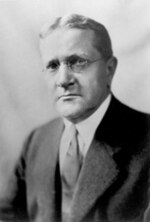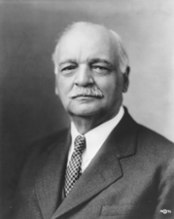Top Qs
Timeline
Chat
Perspective
70th United States Congress
1927–1929 U.S. Congress From Wikipedia, the free encyclopedia
Remove ads
The 70th United States Congress was a meeting of the legislative branch of the United States federal government, consisting of the United States Senate and the United States House of Representatives. It met in Washington, D.C., from March 4, 1927, to March 4, 1929, during the last two years of Calvin Coolidge's presidency. The apportionment of seats in the House of Representatives was based on the 1910 United States census.
Both chambers had a Republican majority - albeit reduced from the previous Congress - and along with President Coolidge, the Republicans maintained an overall federal government trifecta.[1]
Remove ads
Major events
- November 6, 1928: U.S. Senate elections and U.S. House elections

- This was the last Congress to be exclusively white and the last to not have a single black member of Congress in either chamber.
Major legislation
- March 10, 1928: Settlement of War Claims Act
- May 15, 1928: Flood Control Act of 1928 (Jones–Reid Act)
- May 22, 1928: Merchant Marine Act of 1928 (Jones–White Act)
- May 22, 1928: Forest Research Act (McSweeney–McNary Act)
- May 22, 1928: Capper–Ketcham Act
- May 28, 1928: Welsh Act
- May 29, 1928: Revenue Act of 1928, ch. 852, 45 Stat. 791
- May 29, 1928: Reed–Jenkins Act
- December 21, 1928: Boulder Canyon Project Act (Hoover Dam)
- December 22, 1928: Color of Title Act
- January 19, 1929: Hawes–Cooper Act
- February 18, 1929: Migratory Bird Conservation Act (Norbeck–Anderson Act), ch. 257, 45 Stat. 1222
- February 25, 1929: Mount Rushmore National Memorial Act (Norbeck-Williamson Act of 1929)
- March 2, 1929: Increased Penalties Act (Jones–Stalker Act)
Remove ads
Party summary
Summarize
Perspective

2 Democrats (19 states)
2 Republicans (18 states)
1 Democrat and 1 Republican (11 states)
1 Republican and 1 Farmer-Labor (1 state)
The count below identifies party affiliations at the beginning of the first session of this Congress, and includes members from vacancies and newly admitted states, when they were first seated. Changes resulting from subsequent replacements are shown below in the "Changes in membership" section.
Senate
At the end of the first month of the first session of Congress, Republicans gained control of the Senate through a VP-tie-breaking majority.
House of Representatives
Remove ads
Leadership
Senate President
Charles G. Dawes (R)
Senate Presidents pro tempore
George H. Moses (R)
House Speaker
Senate
Majority (Republican) leadership
Minority (Democratic) leadership
House of Representatives
Majority (Republican) leadership
Minority (Democratic) leadership
Remove ads
Members
Summarize
Perspective
This list is arranged by chamber, then by state.
Senate
Senators are listed by class. They were elected every two years, with one-third beginning new six-year terms with each Congress. Preceding the names in the list below are Senate class numbers, which indicate the cycle of their election. In this Congress, Class 1 meant their term ended with this Congress, requiring re-election in 1928; Class 2 meant their term began in the last Congress, requiring re-election in 1930; and Class 3 meant their term began with this Congress, requiring re-election in 1932.
House of Representatives
Members of the House of Representatives are listed by district.
Remove ads
Changes in membership
Summarize
Perspective
The count below reflects changes from the beginning of the first session of this Congress.
Senate
House of Representatives
- Replacements: 15
- Democratic: 1 seat net gain
- Republican: 1 seat net loss
- Deaths: 16
- Resignations: 7
- Total seats with changes: 23
Remove ads
Committees
Summarize
Perspective
Lists of committees and their party leaders for members of the House and Senate committees can be found through the Official Congressional Directory at the bottom of this article. The directory after the pages of terms of service lists committees of the Senate, House (Standing with Subcommittees, Select and Special) and Joint and, after that, House/Senate committee assignments. On the committees section of the House and Senate in the Official Congressional Directory, the committee's members on the first row on the left side shows the chairman of the committee and on the right side shows the ranking member of the committee.
Senate
|
House of Representatives
|
Joint committees
- Conditions of Indian Tribes (Special)
- Disposition of (Useless) Executive Papers
- Harriman Geographic Code System
- Investigation of Northern Pacific Railroad Land Grants
- Determine what Employment may be Furnished Federal Prisoners (Chairman: Rep. George S. Graham)
- Investigate Northern Pacific Lands (Chairman: Rep. Nicholas J. Sinnott)
- The Library (Chairman: Sen. Simeon D. Fess)
- Printing (Chairman: Sen. George H. Moses)
- Taxation (Chairman: Rep. William R. Green)
- To Investigate the Salaries of Officers and Employees of the Senate and the House
Remove ads
Caucuses
- Democratic (House)
- Democratic (Senate)
Officers
Legislative branch agency directors
- Architect of the Capitol: David Lynn
- Attending Physician of the United States Congress: George Calver, from 1928
- Comptroller General of the United States: John R. McCarl
- Librarian of Congress: Herbert Putnam
- Public Printer of the United States: George H. Carter
Senate
- Chaplain: John J. Muir, (Baptist), until December 5, 1927
- ZeBarney T. Phillips (Episcopal), from December 5, 1927
- Secretary: Edwin P. Thayer
- Librarian: Edward C. Goodwin
- Sergeant at Arms: David S. Barry
House of Representatives
- Chaplain: James S. Montgomery (Methodist)
- Clerk: William T. Page
- Doorkeeper: Bert W. Kennedy
- Reading Clerks: Patrick Joseph Haltigan (D) and Alney E. Chaffee (R)
- Sergeant at Arms: Joseph G. Rodgers
- Parliamentarian: Lewis Deschler, from 1928
- Postmaster: Frank W. Collier
See also
- 1926 United States elections (elections leading to this Congress)
- 1928 United States elections (elections during this Congress, leading to the next Congress)
Notes
- Frank L. Smith (R-IL) was elected to the Senate for the term starting March 4, 1927, but the Senate refused to qualify him due to charges of corruption concerning his election. He resigned February 9, 1928.[2]
- William S. Vare (R-PA) was elected to the Senate for the term starting March 4, 1927, but the Senate refused to qualify him due to charges of corruption and fraud concerning his election. In the next Congress, the Senate unseated him.[3]
Remove ads
References
External links
Wikiwand - on
Seamless Wikipedia browsing. On steroids.
Remove ads













